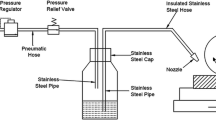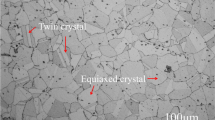Abstract
Fluid application in grinding is getting attention as higher stock removal rates, higher surface integrity and longer wheel life are required. It is necessary to define proper conditions of application for meeting high productivity goals by lowering the specific grinding energy and reducing the temperature of the contact zone. The present study investigated the capacity of the jet pressure of a spot nozzle to improve the wear of a CBN wheel when grinding the AISI 690 superalloy. Grinding experiments were conducted with an emulsion-type cooling fluid delivered at pressure ranging from 0.1 to 4 MPa. Results show that the maximum stock removal, reached at 4 MPa, is 5 times the stock removal obtained at 0.1 MPa, while the grinding ratio at 4 MPa is 8 times that at 0.1 MPa, and there is a critical pressure (P c) around 1.5 MPa corresponding to the minimum specific grinding energy. Scanning electron microscopy of the grain tips showed that the wear mechanism shifts from breaking and dislodgment at low jet pressure to micro-fracture resulting in continuous self-sharpening of the abrasive grains. By lubricating at jet pressure close to P c, there is less thermal damage due to plowing and sliding and the resulting lower loading of the abrasive grains favors the micro-fracture of grains and thus a longer wheel life.













Similar content being viewed by others
References
S. Malkin, Grinding Technology Theory and Application of Machining with Abrasives, 2nd ed., Ellis Horwood Limited, Chichester, 2008
C. Guo, Y. Wu, V. Varghese, and S. Malkin, Temperatures and Energy Partition for Grinding with Vitrified CBN Wheels, Ann. CIRP, 1999, 48(1), p 247–250
J.A. Kovach and S. Malkin, Thermally Induced Grinding Damage in Superalloy Materials, Ann. CIRP, 1988, 37(1), p 309–312
H. Adibi, S.M. Rezaei, and A.A.D. Sarhan, Investigation on Using High-Pressure Fluid Jet in Grinding Process for Less Wheel Loaded Areas, Int. J. Adv. Manuf. Technol., 2014, 70(9), p 2233–2240
R.A. Irani, R.J. Bauer, and A. Warkentin, A Review of Cutting Fluid Application in the Grinding Process, Int. J. Mach. Tools Manuf., 2005, 45(15), p 1696–1705
M. Hadad, An Experimental Investigation of the Effects of Machining Parameters on Environmentally Friendly Grinding Process, J. Cleaner Prod., 2015, 108(Part A), p 217–231
S. Debnath, M.M. Reddy, and Q.S. Yi, Environmental Friendly Cutting Fluids and Cooling Techniques in Machining: A Review, J. Cleaner Prod., 2014, 83, p 33–47
R.D. Monici, E.C. Bianchi, R.E. Catai, and P.R. De Aguiar, Analysis of the Different Forms of Application and Types of Cutting Fluid Used in Plunge Cylindrical Grinding Using Conventional and Superabrasive CBN Grinding Wheels, Int. J. Mach. Tools Manuf., 2006, 46(2), p 122–131
B. Ben Fathallah, N. Ben Fredj, H. Sidhom, C. Braham, and Y. Ichida, Effects of Abrasive Type Cooling Mode and Peripheral Grinding Wheel Speed on the AISI, D2 Steel Ground Surface Integrity, Int. J. Mach. Tools Manuf., 2009, 49(3–4), p 261–272
E. Brinksmeier, C. Heinzel, and M. Wittmann, Friction, Cooling and Lubrication in Grinding, Annals of CIRP, 1999, 48(2), p 581–598
F. Engineer, C. Guo, and S. Malkin, Experimental Measurement of Fluid Flow Through the Grinding Zone, ASME J. Eng. Ind., 1992, 114, p 61–66
J.A. Webster, C. Cui, and R.B. Mindek, Jr., Grinding Fluid Application System Design, Ann. CIRP, 1995, 4(1), p 333–338
J.A. Webster, Improving Surface Integrity and Economics of Grinding by Optimum Coolant Application, with Consideration of Abrasive Tool and Process Regime, J. Eng. Manuf., Part B, 2007, 221, p 1665–1675
B. Mandal, R. Singh, S. Das, and S. Banerjee, Development of a Grinding Fluid Delivering Technique and its Performance Evaluation, Mater. Manuf. Process., 2012, 27, p 436–442
S. Ebbrell, N.H. Woolley, Y.D. Tridimas, D.R. Allonson, and W.B. Rowe, The Effects of Cutting Fluid Application Methods on the Grinding Process, Int. J. Mach. Tools Manuf., 2000, 40, p 209–223
K. Ramesh, H. Huang, and L. Yin, Analytical and Experimental Investigation of Coolant Velocity in High Speed Grinding, Int. J. Mach. Tools Manuf., 2004, 44, p 1069–1076
M.N. Morgan and V. Baines-Jones, On the Coherent Length of Fluid Nozzles in Grinding, Key Eng. Mater., 2009, 404, p 61–67
E.J. Da Silva, E.C. Bianchi, J.F.G. De Oliveira, and P.R. De Aguiar, The Inlet Engine Valves Grinding Using Different Cutting Fluids and Grinding Wheels, Mater. Res., 2002, 5(2), p 187–194
M.N. Morgan, A.R. Jackson, H. Wu, V. Baines-Jones, A. Batako, and W.B. Rowe, Optimisation of Fluid Application in Grinding, Ann. CIRP, 2008, 57, p 363–366
J. Steffen, R. Bauer, and A. Warkentin, Performance of a Coherent Jet Coolant System in Non-Continuous Dress Creep-Feed Grinding of Inconel 718, J. Adv. Manuf. Syst., 2005, 4(2), p 117–130
E. Rouly, R.J. Bauer, and A. Warkentin, An Investigation into the Effect of Nozzle Shape and Jet Pressure in Profile Creepfeed Grinding, J. Eng. Manuf., Part B, 2015. doi:10.1177/0954405415584960
R. Kovacevic and R. Mohan, Effect of High Speed Grinding Fluid on Surface Grinding Performance, Technical Papers of the 1st International Machining and Grinding Conference, Dearborn, Michigan, 1995, p 917–931
D. Jia, C. Li, Y. Zhang, D. Zhang, and X. Zhang, Experimental Research on the Influence of the Jet Parameters of Minimum Quantity Lubrication on the Lubricating Property of Ni-Based Alloy Grinding, Int. J. Adv. Manuf. Technol., 2015, 82(1), p 617–630
L.R. Silva, M.F. Mattos, L.V. Amaral, E.C.S. Corrêa, and J.R. Brandão, Behavior of Surface Integrity in Cylindrical Plunge Grinding Using Different Cooling Systems, Mater. Res., 2011, 14(2), p 206–211
Y. Ichida and K. Kishi, The Development of Nanocrystalline CBN for Enhanced Superalloy Grinding Performances, Trans. ASME J. Manuf. Sci. Eng., 1997, 119, p 110–117
C. Guo, Z. Shi, H. Attia, and D. Mclntosh, Power and Wheel Wear fro Grinding Nickel Alloy with Plated CBN Wheels, Ann. CIRP, 2007, 56, p 343–346
Z. Zhao, Y. Fu, J. Xu, and Z. Zhang, Behavior and Quantitative Characterization of CBN Wheel Wear in High-Speed Grinding of Nickel-Based Superalloy, Int. J. Adv. Manuf. Technol., 2016, 86(1), p 1–11
K.V. Kumar Superabrasive Grinding of Specialty Materials such as Superalloys, Titanium Alloys and Intermetallic Alloys, Proceedings of the 3 rd International Conference on High Technology, Chiba, 1992, p 31–45.
American Society of Metals, Handbook of Machining, 9th ed
Y. Hauda, A. Hamda, and Y. Koburi, Grinding of Superalloys Using Metal-Bonded CBN Wheel, Key Eng. Mater., 2012, 523, p 163–168
S.Y. Luo, Characteristics of Diamond Sawblade Wear in Sawing, Int. J. Mach. Tools Manuf., 1996, 36(6), p 61–672
K. Martin and K. Yegenoglu, HSG-Technologie – Handbuch zur praktischen Anwendung, Hrsg.: Guehring Automation GmbH, Stetten a.k.M.-Frohnstetten (1992)
R.C. Pung and CBN Grinding Technology Update, Modern Grinding Technology, Southfield, Michigan, SME Technical Paper, MR87-813.
B. St-Pierre, J.F. Chatelain, and L. Dufresne, Development of a Semi-Empirical Model Based on CFD Results for the Prediction of coolant Jet Coherency for Grinding Application, Trans. Can. Soc. Mech. Eng., 2012, 36, p 127–142
Y. Ichida, B. Ben Fredj and N. Usui, The Micro-Fracture Wear of Cutting Edges in CBN Grinding, Proceedings of the 2nd International ABTEC Conference, Taiwan, (1995), p 501–504.
N. Ben Fredj, Y. Ichida, K. Kishi and X. Lei, Wear Mechanism of CBN Wheel in Creep Feed Grinding, Proceedings of the 1st International Conference on Progress of Cutting and Grinding, Beijing, (1992) p 227–232.
T. Kato and H. Fujii, Energy Partition in Conventional Surface Grinding, Trans. ASME J. Manuf. Sci. Eng., 1999, 121, p 393–398
Author information
Authors and Affiliations
Corresponding author
Rights and permissions
About this article
Cite this article
Guitouni, A., Chaieb, I., Rhouma, A.B. et al. Effects of Jet Pressure on the Ground Surface Quality and CBN Wheel Wear in Grinding AISI 690 Nickel-Based Superalloy. J. of Materi Eng and Perform 25, 5055–5064 (2016). https://doi.org/10.1007/s11665-016-2330-y
Received:
Revised:
Published:
Issue Date:
DOI: https://doi.org/10.1007/s11665-016-2330-y




